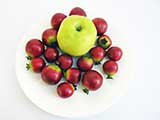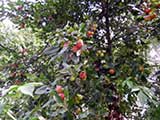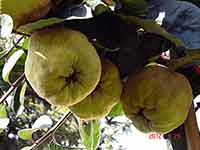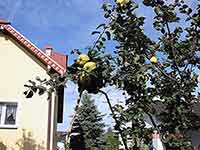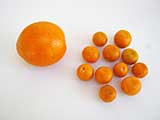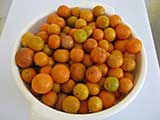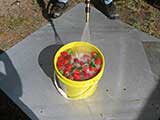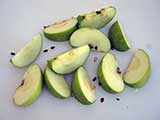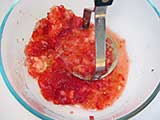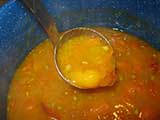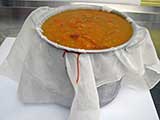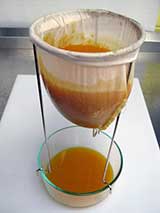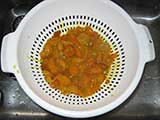Meats and Sausages
Fruits for Making Jam and Jelly
Top quality fruit results in top quality jams and jellies. To make a good jelly, the fruit must contain the proper amount of pectin and acid. Only few fruits contain a sufficient amount of pectin and acid to produce good jelly or jam. Other fruits may be rich in pectin but low in acid or vice versa. Such deficiencies can be compensated for by adding commercial pectin and/or acid (lemon juice, citric acid, vinegar).
Carefully selecting the same even fruit will also overcome some of the problems. It should be noted that both the pectin and acid decrease as the fruit ripens. So, using over-ripe fruit may result in a very soft gel or no gel at all. Often a combination of fully ripe and less ripe fruit is used. For example, choosing 1/4 immature apples and 3/4 fully matured ones brings a better result than choosing only fully matured fruit. The under ripe fruit provides pectin and acid and the mature fruit gives flavor and color.
The fruits are grouped according to their pectin and acid content:
- Pectin rich fruits: crabapples, sour apples, lemons, partially ripened oranges, Kumquat, pomegranate, cranberries, partially ripened grapes, damson plums, sour cherries, melons, quinces.
- Pectin poor fruits: peaches, blueberries, strawberries, peaches, pineapple, rhubarb, grapefruit, guavas. Low pectin in these fruits can be compensated for by adding some green apple, apple pectin stock, or orange pectin stock.
- High acid fruits: currants, raspberries, crabapples and grapes.
- Low acid fruits: pears, peaches, blueberries and sweet apples, sweet cherries, melons.
Strawberries and apricots contain sufficient acid, but are low in pectin. Peaches, pears and figs are generally low in both acid and pectin.
The preferred fruits for making jelly: crabapples, sour apples, sour berries, sour cherries, grapes, Kumquats, and cranberries. These fruits contain sufficient amounts of pectin and acid to gel. At first look it might seem that the finished product will have an acidic taste, but let's not forget that a considerable amount of sugar will be added, making the product delicious and of the proper texture.
A concentrated apple juice can be made by cooking down the juice obtained from crushed apples. It is commonly referred to as boiled cider and it can be used in many recipes. Boiled cider contains solid particles and enough acid to be easily preserved. Many fruit juices are not easy to obtain so it is practical to make concentrated juices from such fruits for future use.
Frozen and Canned Fruits
Frozen or canned fruits/juices can be used to make jellied products. One may want to make a jellied product from a fruit that is not available in his area or he may have an abundance of fruit on his farm. Such fruit can be frozen or canned for later use. Commercially canned or frozen fruits are made from fully ripe fruit and may contain insufficient amounts of pectin to produce gel. In such a case commercial pectin should be added. Commercial products without added sugar should be selected. If you freeze or can your own fruit, try to select 1/4 under ripe and 3/4 fully ripe. This assures you a sufficient pectin amount to produce gel.
Crabapple - is sometimes called wild apple, since the trees and fruit have a more wild look. As a general rule, crabapple trees are smaller than regular apple trees, and they may develop twisted, gnarled branches and thorns. The small fruits may be yellow to red when ripe, and they often grow in dense clusters. The flavor is sour and tart, much like biting into a lemon. The place where crabapples shine best is crabapple jelly. The small fruits are high in pectin, and when they are cooked with sugar, they develop a rich, flavorful, very tart ruby red jelly which is quite pleasing. Crabapple jelly may be used on its own or combined with other fruits.
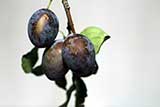
Damson plum - Damsons were first cultivated in antiquity in the area around the ancient city of Damascus, capital of modern-day Syria, and were introduced into England by the Romans. Today this lovely plum can be found not only in the Middle East and Eastern Europe but it is also grown in Western Europe, Great Britain, and the US. These plums are usually oval in shape and have a dark purple skin. In the past, their skins were used to create dyes. Today, they are most commonly used to make jams and a plum brandy known as slivovitz.
Quince - is related to apples and pears, and has a pear shaped fruit, which is bright golden yellow when mature. Most varieties of quince are hard and sour, but they are great for making jams and jellies. The flesh of the fruit turns red after a long cooking time. This means that they can be added to jams to enhance the flavor.
Selecting and Preparing Fruits for Jellies
The best fruits for making jellies contain sufficient amounts of pectin and acid. Crabapples, sour apples preferably, not over matured, sour berries (not blueberries), sour cherries, grapes, citrus fruits and cranberries. These are not sweet fruits and at first look it might seem than the finished product might have a sourly taste, but let's not forget that a considerable amount of sugar will be added making the product delicious and of proper texture.
Fruit Preparation
Wash fruit and discard any damaged parts. Remove stem and blossom ends. Do not remove skins, pits, seeds and cores as these contain most pectin. They will be filtered, anyhow.
Juice Extraction
Place fruit into a pot and add a little water:
- Chop hard fruits like apples into smaller pieces and add around 1 cup of water per pound of fruit.
- Crush soft fruit like raspberries or grapes to start the flow of juice and add only enough water to prevent scorching.
- Bring to a boil, stir and reduce heat to a gentle boil.
- Apples and hard fruits - 20-25 minutes
- Berries and grapes - 10 minutes
Excess boiling destroys pectin and affects flavor and color.
Filtering
The boiled pulp is pressed through a strainer and filtered through a jelly bag or through a colander which is lined up with two or more thicknesses of a cheese cloth.
Pour the mixture into a damp jelly bag and let it drain for at least 2 hours, preferably overnight. Do not press or squeeze the bag as this will affect the clarity of the jelly. That will prevent any larger fruit particles from leaking through and will produce a cleaner jelly. One pound of fruit will generally produce 1 cup of juice.
The remaining pulp may be recombined with a little water and boiled again to produce more pectin. In a factory the pH (acidity) value, pectin content, and soluble solids content of the juice is calculated by analysis. In home production we have to rely on simpler tests.
Estimating the Amount of Pectin
For jellies made without added pectin it is necessary to know whether juice contains enough natural pectin to form a gel. Test the juice for pectin. If the juice satisfies the test, the juice will gel. More about juice extraction (link to jams-jellies-testing).

